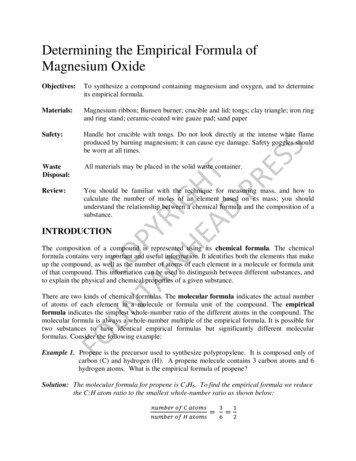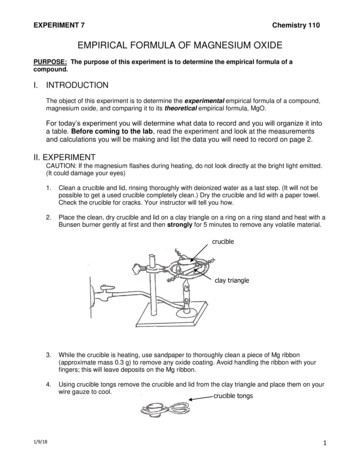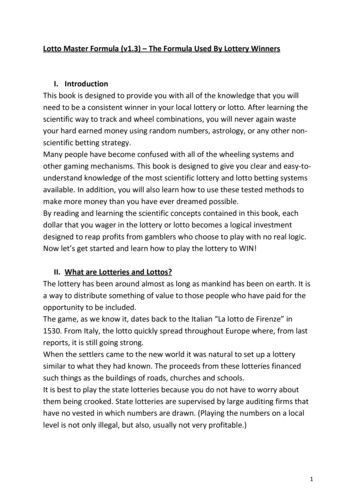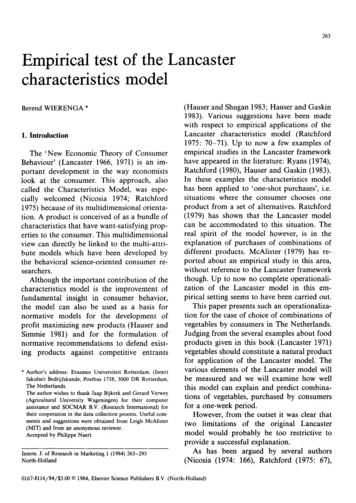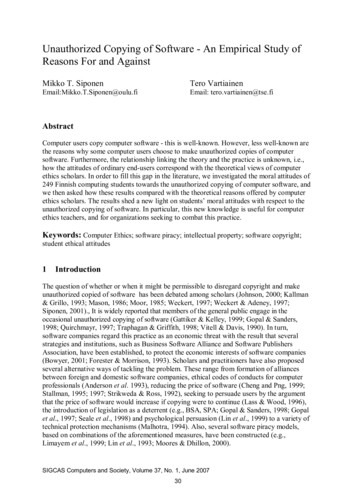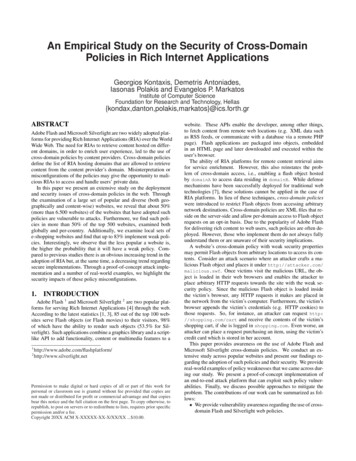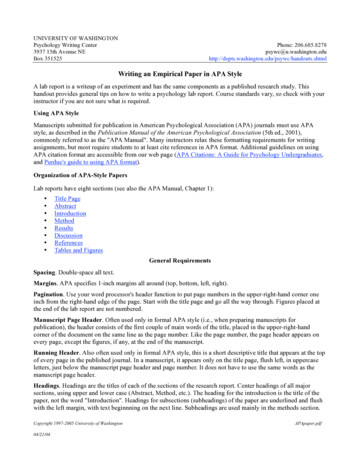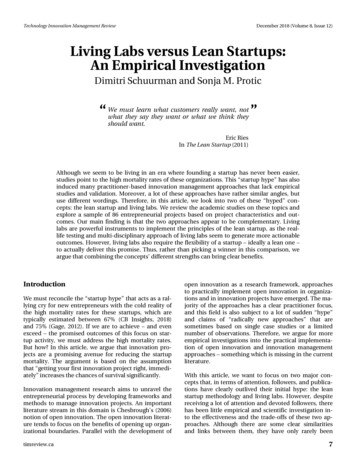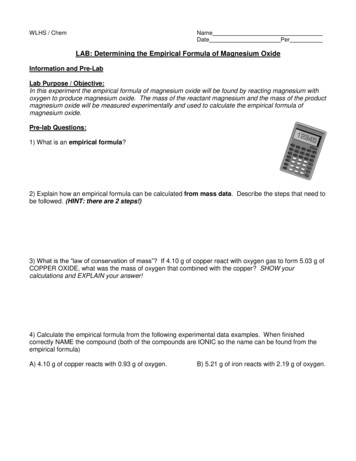
Transcription
WLHS / ChemNameDatePerLAB: Determining the Empirical Formula of Magnesium OxideInformation and Pre-LabLab Purpose / Objective:In this experiment the empirical formula of magnesium oxide will be found by reacting magnesium withoxygen to produce magnesium oxide. The mass of the reactant magnesium and the mass of the productmagnesium oxide will be measured experimentally and used to calculate the empirical formula ofmagnesium oxide.Pre-lab Questions:1) What is an empirical formula?2) Explain how an empirical formula can be calculated from mass data. Describe the steps that need tobe followed. (HINT: there are 2 steps!)3) What is the “law of conservation of mass”? If 4.10 g of copper react with oxygen gas to form 5.03 g ofCOPPER OXIDE, what was the mass of oxygen that combined with the copper? SHOW yourcalculations and EXPLAIN your answer!4) Calculate the empirical formula from the following experimental data examples. When finishedcorrectly NAME the compound (both of the compounds are IONIC so the name can be found from theempirical formula)A) 4.10 g of copper reacts with 0.93 g of oxygen.B) 5.21 g of iron reacts with 2.19 g of oxygen.
5) Using the values from the previous question, what is the ratio of moles of copper to moles of oxygen?(We want to express this value as a decimal instead of a fraction. Do not round your answer to a wholenumber. For example: 0.0889 / 0.0865 1.028)6) What type of compound would magnesium oxide be? What should its empirical formula be? Explainhow you know this.7) The reaction between magnesium and oxygen that forms magnesium oxide can be written as thefollowing word equation. In the space below the word equation, write the chemical equation for thisreaction and then BALANCE it! (note: the formula for oxygen is O2). Also, indicate the TYPE of reaction.magnesium oxygen magnesium oxideBalanced equation:Type of reaction:8) This reaction will occur by placing a long narrow strip of magnesium (you will measure / know itsmass) into a crucible and heating it to start the reaction. Where will the oxygen come from for thereaction?9) When the reaction is complete, only magnesium oxide should be present inside of the crucible.Briefly explain how the mass of the magnesium oxide can be found.10) Explain how the mass of the oxygen that reacted can be found.STAMP
WLHS / ChemNameDatePerLAB: Empirical Formula of Magnesium OxideData Collection and AnalysisMaterials:crucible and lidcrucible tongsring stand and clay triangleBunsen burnermagnesium ribbonsafety goggles0.01 g precision electronic balanceWEAR SAFETY GOGGLES!BEWARE OF HOT CRUCIBLES!Procedure:1) Set up: Place a crucible and lid on a clay triangle clamped to a ring stand. Light the gas burner andadjust it to give a clear blue inner flame. Place the burner under the crucible. Adjust the height of thering support so that the bottom of the crucible is in the hottest part of the flame. Place the crucible lidslightly ajar on the crucible.2) Perform the lab and collect all the data necessary. DO NOT ATTEMPT TO HANDLE A HOTCRUCIBLE! Place the hot crucible on the metal base and let it cool for a few minutes beforemoving it at all.3) Clean up: Clean the crucible by scraping the magnesium oxide into the garbage with a metal spatula.DO NOT CLEAN THE CRUCIBLE BY USING WATER.4) Begin working on the analysis section.Data: (include appropriate units!)Trial 1Mass of empty crucibleand lidMass of magnesiumribbonMass of crucible, lid andfinal productObservationsFuture TrialFuture Trial
Analysis:Perform each of the following calculations. Show mathematical work including units for eachcalculation.1) Calculate the mass of magnesium oxide in the crucible at the end of the reaction.2) Calculate the mass of oxygen that reacted in the lab using the law of conservation of mass.3) Calculate the number of moles of magnesium that reacted in the lab using dimensional analysis.4) Calculate the number of moles of oxygen that reacted in the lab using dimensional analysis.5) Calculate the mole ratio of magnesium to oxygen by dividing the moles of magnesium by the moles ofoxygen. Round the answer to 3 decimal places.6) The theoretical mole ratio of magnesium to oxygen should be 1.000. Calculate the experimental error.Table of analysis examples and valuesMass of magnesiumoxideEquation/Substitution/AnswerMass of oxygenEquation/Substitution/AnswerMoles of magnesiumDimensional AnalysisMoles of oxygenDimensional AnalysisMole ratio: Mg/OEquation/Substitution/AnswerExperimental errorEquation/Substitution/Answer
Post-Lab Questions / Analysis:1) According to your results, what is the mole ratio of magnesium to oxygen, to the nearest 0.001?2) Was your mole ratio of magnesium to oxygen higher or lower than the theoretical value?3) Scenario #1: Someone did this same lab and collected the following results: Magnesium mass 0.520 g and Oxygen mass 0.25 g.A) Calculate the experimental mole ratio of Magnesium:Oxygen (do not round to whole numbers – keepthe decimals)?B) Which element’s mass was smaller than it theoretically should have been?4) Scenario #2: Someone did this same lab and collected the following results: Magnesium mass 1.505 g and Oxygen mass 1.10 g.A) Calculate the experimental mole ratio of Magnesium:Oxygen (do not round to whole numbers – keepthe decimals).B) Which element’s mass was smaller than it theoretically should have been?**For each experimental scenario below, predict and EXPLAIN the effect on the mole ratio ofMg/O. (Hint: would the ratio be greater than or lower than 1?)5) After completing the reaction, not all of the magnesium reacted.6) Some of the product is “lost” before the final mass is measured.7) Noticeable residue was in the crucible and not removed prior to performing the reaction.
8) Based on the mole ratio of Mg/O that you calculated using your data, brainstorm 2-3 proceduralreasons that would explain why the experimental ratio was NOT 1.000.9) Using the questions above and your results and observations from the lab, what best explains theobserved experimental % error? Be specific and use your results (evidence) to support a claim withsound reasoning. In the space below, write a thorough explanation (CLAIM, EVIDENCE, REASONING).CLAIM – EVIDENCE – REASONING Claim: Provide a reason for the % error Evidence: Provide data to support your claim (moles of oxygen observed compared to moles ofoxygen that theoretically should have been observed) Reasoning: Logical explanation of HOW your evidence supports your claim.
WLHS / ChemNameDatePerLAB: Empirical Formula of Magnesium Oxide**REDESIGN: Address the reason for the % error observed!Trial 1 Mg/O mole ratio (do not round):Claim that explains WHY ratio of Mg/O was NOT 1.000:Proposed procedure modification(s) or emphasis to the procedure that address the claim:stampInstructions:1) Repeat the data collection and record your data in the original data table. *use “future trial” column(s)2) Show all your work for the calculations to find the Magnesium:Oxygen mole ratio in the space below.Clearly show the work (including the experimental error for the new trial(s)).(over for final conclusion instructions!)
3) Was your procedure modification effective? Use CLAIM – EVIDENCE – REASONING. Use thespace below. Claim: Was your modification effective? Evidence: Provide data to support your claim (compare the ratio of Mg/O from the first and secondtrials) Reasoning: Logical explanation of why your procedure modification improved, or did not improve yourresults.
LAB: Determining the Empirical Formula of Magnesium Oxide Information and Pre-Lab Lab Purpose / Objective: In this experiment the empirical formula of magnesium oxide will be found by reacting magnesium with oxygen to produce magnesium oxide. The mass of the reactant magnesium and the mass of the product
